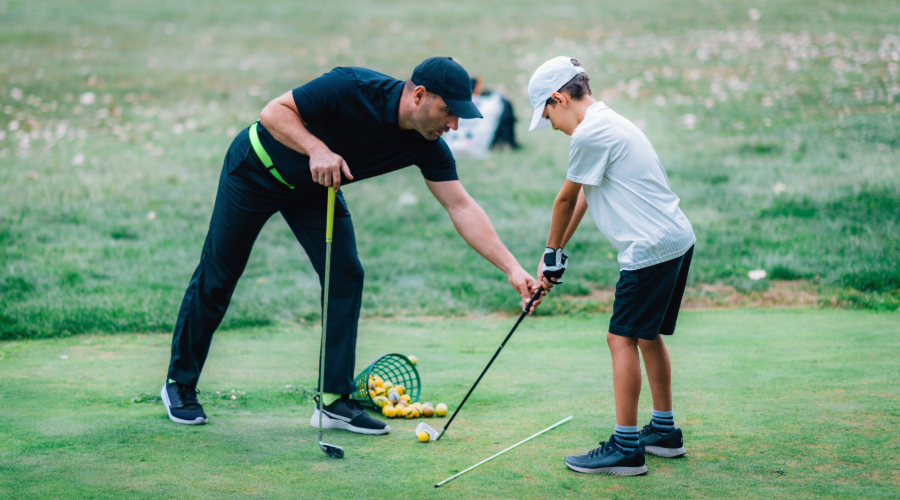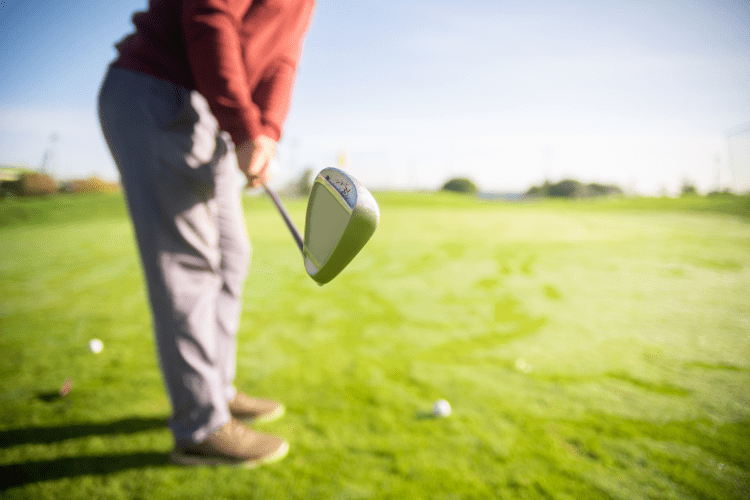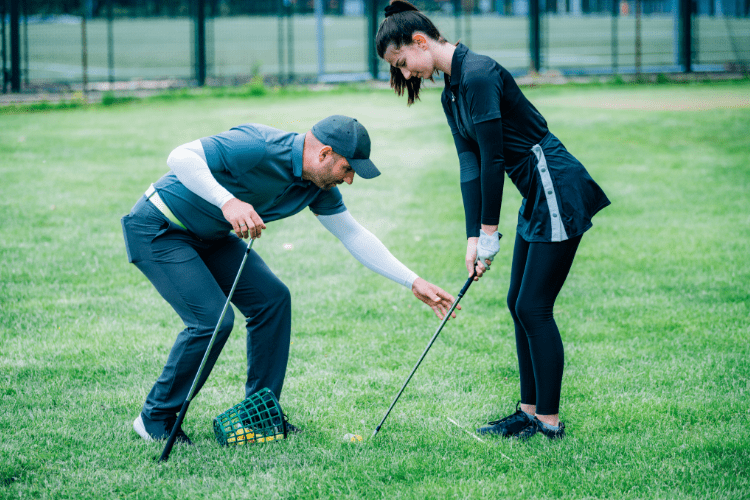Master Your Golf Stance
Posted by

Golf isn’t just a casual pastime—it’s a mix of skill, focus, and the right body positioning.
Imagine standing on the fairway, the breeze brushing past, and mentally visualizing the ball’s path. A solid stance can be the game-changer that turns good shots into great ones.
While getting caught up in perfecting your golf swing sequence, remember that your stance sets the foundation for everything that follows.
By dialing in your stance, you’ll boost your balance, make better contact, and gain a new level of confidence on the golf course. Ready to see how it all clicks together?
Golf Stance Basics
When you step onto the tee, it’s easy to get lost in focusing on the target. That’s not a bad thing!
But proper golf stance is actually the foundation that connects your body to the club and the ball. When it’s steady, you create a solid base that sets you up for smoother swings. Think of it like a house—if the foundation is shaky, everything else wobbles.
Let’s break down why stance is so important and the key elements that make it strong and reliable.
Why Golf Stance Matters

Ever hit a shot that just didn’t feel right? It often comes down to how your feet, hips, or shoulders are set. A balanced stance lets you transfer power smoothly through your body instead of losing it along the way.
Picture pushing a child on a swing—you need a solid footing to really get some force behind that push. A strong, grounded posture helps you deliver more power at impact, giving your shot that extra zip.
Plus, it keeps the clubface aligned with the golf ball, which means more consistency and better ball flight.
- A solid stance helps you maintain balance throughout the swing.
- Proper footing allows for smoother power transfer, increasing ball speed.
- Aligning your posture with the target gives you more consistent aim and accuracy.
Key Elements of a Good Stance

Proper stance includes several parts working together: foot placement, knee bend, spine angle, and shoulder alignment. It’s like balancing on a narrow board—any shift can throw you off. The same goes for golf.
Keep these key points in mind for a steady, repeatable stance:
- Feet: Position your feet shoulder-width apart for balance.
- Knees: Slightly bend your knees to stay active—don’t overdo it and crouch.
- Spine: Keep your spine stable and lean just slightly forward from your hips.
- Shoulders: Align your shoulders along the target line to guide the swing path.
Once these basics are set, you’ll have the perfect golf stance that feels natural and easy to repeat.
How to Position Your Feet and Shoulders

When your feet are in the right place and your shoulders are aligned properly, the rest of your swing just flows. This setup helps you aim more accurately and stay balanced through your backswing and follow-through.
Let’s break down how to get these key elements in check.
Aligning Your Feet for Balance
Foot placement plays a huge role in where the ball ends up. A simple rule of thumb is to keep your feet about shoulder-width apart for a stable, flexible base.
Your front foot should point a little toward the target while your back foot stays mostly straight. To picture this, think of skiing on twin tracks: both feet stay aligned to keep your weight balanced instead of tilting in or out.
- Feet too wide apart? You might lose some rotation.
- Feet too close together? You could feel a bit wobbly.
The sweet spot is a stance that feels solid yet allows you to move freely—firm but agile.
Proper Shoulder Alignment
Your shoulders act like the steering wheel of your swing. When they’re level with the target line, the club stays on track.
Here’s a simple trick: place a spare club across your shoulders at address. Check where the club points in relation to your target. If it’s angled too much left or right, adjust your shoulder alignment. Even a small tweak can make a big difference.
When your shoulders are aligned properly, your arms will move smoothly through the swing, letting the clubhead meet the ball squarely. This consistency helps you hit your shots more accurately and with better control.
Adjusting Your Stance for Different Clubs

Each club has its own unique design—whether it’s length, loft, or overall feel—so it’s important to tweak your stance depending on what you’re using. You wouldn’t swing a driver the same way you would a wedge, right?
These small adjustments—like foot width, ball position, and posture—might seem subtle, but they can make a big difference in your distance control and direction.
Whether you’re working with a driver, iron, or wedge, making these tweaks can seriously improve your game.
If you want some personalized guidance on making these adjustments, Skillest can be a great tool. You can send videos of your stance and swing to an online golf instructor who’ll give you expert feedback tailored to your needs, helping you get the right feel for each club.
Let’s break down what to focus on for drivers, irons, and wedges.
Driver Stance Tips
The driver is all about distance, so a slightly wider stance helps you tap into that power. Position the ball closer to your front foot to let the club meet it on an upward path.
You’ll often see players tilt their lead shoulder just a little higher to encourage a smooth sweeping motion. That tilt not only makes the shot feel fluid but also helps reduce spin, sending the ball flying straight and far.
Keep your base stable while staying relaxed with your arms for a more powerful strike.
Iron Stance Adjustments
For mid and long irons, you’ll want the ball more centered in your stance. This position helps you make contact on a descending path, leading to crisp shots and the perfect trajectory.
Keep your stance moderately wide—it gives you a solid balance of power and accuracy. A gentle knee bend helps with rotation, so your hips guide the club through the ball.
Once you start feeling that clean, solid strike, confidence will follow!
Wedge Stance Techniques
With wedges, it’s all about control and precision rather than power. You might find that bringing your feet a little closer together helps with that finesse.
Many players position the ball in the middle or slightly toward the back of their stance to ensure a clean strike. This setup generates more spin, which is perfect for those delicate shots around the green.
Stay calm in your upper body and let the club do the work. This will help your shots land softly with a predictable result.
Perfecting Your Posture

Nailing the correct golf posture is the foundation of a smooth, powerful swing. Getting it right helps you move more freely, improve your consistency, and prevent common aches. Here’s a quick guide to help you perfect your posture so you can play your best.
Good Posture = A Better Swing
- The right posture helps you rotate smoothly, preventing aches and ensuring a consistent shoulder turn.
- Avoid standing too upright (limits rotation) or slouching (takes away power). Aim for a balanced, comfortable stance.
- Think of your posture like you’re about to take off on a short run—slightly forward, ready to move, but hinging from the hips instead.
The Role of Knee Flex
- A soft knee bend keeps your lower body engaged, allowing for a smooth weight shift during your swing.
- Avoid locking your knees straight; this will make you feel stiff and rob you of your tempo.
- Don’t bend your knees too much either—it can mess with your rotation. Aim for a gentle bend that allows you to sway naturally with the swing.
- Knee flex helps you feel the ground and is key to balanced, solid contact with the ball.
Maintaining a Straight Spine
- Hinge from the hips (not the waist) to keep your spine aligned from your head to your tailbone.
- A straight spine gives you a solid axis for rotation, while a hunched back can block your shoulder turn.
- Standing too upright might force an over-the-top swing. Find the right angle for your body type.
- Consistency is key—check your posture by recording yourself from the side. A clean angle promotes better rotation and body mechanics.
Finding the Right Ball Position

Ball position is another simple game-changer when it comes to controlling your shot’s flight and direction.
Putting the ball closer to your front foot tends to create a higher ball flight while positioning it near your back foot usually results in a lower, more penetrating shot.
The key to getting it right depends on what you’re trying to achieve, as well as which club you’re using. Think of ball position as that final puzzle piece that helps you tie everything together for a smooth, consistent strike.
Let’s break it down for long shots and shorter clubs.
Ball Placement for Long Shots
- For drivers and fairway woods, place the ball near your front heel. This positioning helps you strike the ball as the club moves upward off the tee, giving you that nice, high launch.
- If the ball is too far back in your stance, you might end up hitting it on a downward angle, leading to extra spin and a shot that balloons into the air.
- A slight tilt of your upper body away from the target will help elevate the ball. Just be sure not to lean too far back, or you might lose balance.
- Try adjusting the ball’s position slightly to see how it impacts your ball’s flight. Small tweaks can make a big difference!
Ball Position for Shorter Clubs
- When you’re using irons or wedges, the ball should sit more in the center of your stance. Many players line it up with the logo on their shirt or just under the center of their chest.
- This positioning helps the club descend into the ball, giving you that crisp, clean strike.
- If the ball is too far forward, you might catch it thin, while placing it too far back could cause you to hit it heavy.
- The sweet spot is usually a balanced position, delivering that satisfying “click” when the club makes contact. Experiment with your setup on the range to find the right ball position for each club.
Tips for Weight Distribution

Getting your weight distribution right can make all the difference in your swing. It affects both power and accuracy, helping you feel more balanced and in control.
Here are some quick tips to ensure you’re on track:
- Balance is key: Even weight distribution helps you rotate smoothly and stay stable. Avoid standing on your heels or toes.
- Start with a 50-50 split: A balanced stance with enough knee bend allows you to feel the ground under your arches.
- Avoid extremes: Don’t stand too tall or squat too much—keep your posture neutral.
- Load your trail foot: During the backswing, shift your weight to your trail foot to set up power.
- Shift to the front foot: As you swing through, smoothly transfer weight to your front foot to release power at the right moment.
Practicing Your Golf Stance
Practice makes perfect, right? It’s not just about the full swing—sometimes, it’s about taking a step back, checking your alignment, and making sure everything feels right.
Here’s how to fine-tune your stance and build consistency over time.
- Use alignment sticks: Place one along your toe line and another for ball position. Step in and check that your feet, legs, hips, and shoulders are aligned. Make slow practice swings focusing on weight transfer. Repetition is key—over time, your body will start locking in the correct stance without thinking about it.
- Record your setup: Take a quick video of yourself to see if anything feels off—like a flared back foot or off-line shoulders. Watching yourself on video can highlight things you might miss while in the moment. If you can, send the footage to an instructor on Skillest for personalized feedback.
Take Your Golf Game to the Next Level

Your stance is the foundation of a good swing—it’s everything. From where your feet are positioned to how your weight is balanced, each detail matters in how the club meets the ball.
When you get your stance dialed in, you’ll stand tall with confidence, hitting shots that reflect that steady foundation. It takes time to get it right but trust us, it’s worth it. A consistent stance can make a huge difference in your game—lowering your scores and giving you a deeper appreciation for golf.
Sometimes, a fresh perspective can really speed things up, and that’s where Skillest can help. The online coaching platform connects you with top-notch golf instructors for golf lessons.
Simply send a video of your stance and swing and get detailed feedback without ever needing to schedule an in-person lesson. With the right guidance, tweaking your stance becomes a lot easier, and your confidence will grow.
Give it a shot, and see how it helps take your game to the next level.
Frequently Asked Questions (FAQ):
What is the correct golf stance?
A good stance means standing with your feet shoulder-width apart, knees slightly bent, and weight evenly distributed. Your back should tilt forward from the hips, and your arms should hang naturally from your shoulders.
What are the three stances in golf?
The three main stances are open, square, and closed. An open stance has the lead foot pulled back a bit. A square stance keeps both feet parallel to the target line. A closed stance has the lead foot slightly forward.
How should your feet be in a golf stance?
Your feet should be about shoulder-width apart. For a mid-iron, align the outsides of your shoulders with the middle of your feet. For a driver, stand a little wider so your insteps line up with your shoulders.
What is the perfect iron golf stance?
For a balanced iron stance, place the ball in the center of your stance. Keep your knees flexed with weight evenly distributed on both feet. A slight tilt from the hips helps your upper body stay in position for a clean strike.
